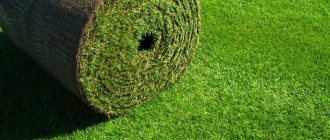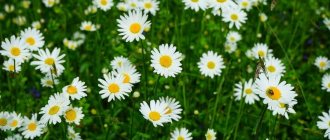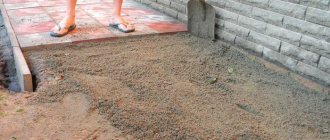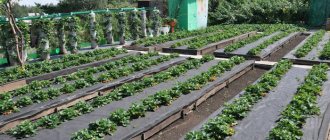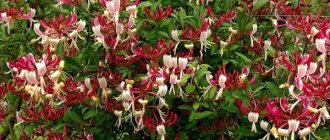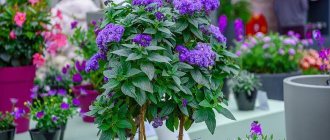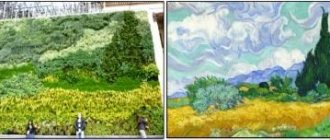If you compare a modern dacha and the one that existed 30 years ago, these are two significant differences. The Soviet one had a sea of garden beds, because it was simply impossible to provide the family with vitamins in any other way. Today there is an abundance of stores, which means you can create a paradise for relaxation at your dacha. And an indispensable attribute of the design was a lush, thick, soft lawn on which you can lie down, like on a carpet, and enjoy the floating clouds. But for the sown grass to please with its beautiful appearance, at least a year must pass, and you don’t want to wait for that. However, there is a simple solution - buy grown grass in a store. Laying a rolled lawn is quite simple and does not require any special skills, but within a month you can have picnics on it.
Specialized nursery companies are engaged in growing rolled turf. The period from sowing the seeds until the finished lawn goes on sale is three years. Most often, the seeds of the most resistant and easy-to-maintain grasses are used: meadow bluegrass and red fescue. In order for the grass to acquire density and density, it is grown for two years. During this time, the lawn has time to grow a strong root system, which will allow it to quickly take root when transplanted. Only in the 3rd year, the finished grass “carpet” along with the roots is cut into layers using special machines and mechanisms. The strips are immediately rolled up so that the root system does not dry out, and transported in coils to places of sale.
- 2 How many rolls will you need to buy?
- 3 Preparing the soil for laying
- 4 Rules for laying rolled grass
- 5 Front of work after planting the lawn
Types of rolled lawn
Turf from lawn grass allows you to create an ideal grass carpet almost anywhere in your summer cottage in a minimum amount of time. This is a big advantage of purchasing a lawn. Mature grass covering has found application in different parts of the dacha: in the garden under the trees, on the playground, in the local area. Rolled lawns are divided into the following main types:
- Parterre lawn.
Refers to an elite coating. Decorative qualities deserve the highest praise. The color of the blades of grass is uniform, their surface is velvety, without the slightest flaws. The disadvantages of parterre grass include high demands on lighting and soil, and sensitivity to watering. You cannot walk on the lawn, this leads to the death of the plants. The capricious lawn is used as a decoration for flower beds and individual areas in the country (where no one goes!). Parterre lawns require special care. - Sports turf
from lawn plants. From the name it is already clear that the lawn is used for sports fields and for playing ball. It is good to lay such a carpet on children's playgrounds. The grasses fescue and ryegrass tolerate trampling, mowing, sun and planting in partial shade. Caring for plants is simple and comes down to the usual care of unpretentious plantings. - Universal lawn
– the most popular covering of lawn grasses. It is this turf that is most often used in dachas. Herbs are resistant to trampling. The lawn responds well to both full sun and partial shade planting. The universal grass covering becomes a decoration of the garden and local area. On such grass you can safely have a picnic with friends. - Shady lawn
. From the name it is clear that this grass cover is planted in the shady areas of the dacha. The planting material used to plant a lawn tolerates a lack of sunlight well. But of all types of lawn, shady lawn requires the most painstaking and diligent care.
Important! No matter how comfortable and lush a shady lawn planted under tall trees may be, like any plant without the sun, it will begin to wither.
To avoid complete destruction of the coating, grasses are periodically sown. It is enough to carry out overseeding once every two years.
It is worth noting that today they also produce synthetic rolled lawns.
Step-by-step launch instructions
- State registration. First of all, you will need to contact the tax authorities and register as an individual entrepreneur (IP) or a Limited Liability Company (LLC). In the classifier of types of activities there is a special item called “Landscape planning services”. The advantage of an individual entrepreneur is that the work is carried out on the basis of a simplified taxation system. If you intend to provide other related services, it is better to register these items immediately so that there are no obstacles to your work in the future.
- Search for office space and land. It is necessary to find a suitable office space and a plot of land on which the lawn will be grown, with an area of at least 0.5 hectares. At the same time, it is important to provide for the possibility of placing a greenhouse on the site if year-round work on the production of lawns is planned. A small room (20-30 m²) is enough for an office, but in addition to it, you need to equip a warehouse for storing rolled lawns (50-60 m²). You can organize two points in different areas of the city. For example, a warehouse is on the outskirts, and an office is in the center. Renting will require approximately 120,000 monthly investments.
- Purchase of equipment. This expense item will be the largest. Equipment you will have to buy: plastic mesh, seeders, garden rollers or rollers for soil compaction, lawn mowers, soil irrigation systems. The investment amount will be approximately 450,000 - 500,000 rubles.
- Planting material. It is presented in multicomponent herbal mixtures and is sold in many stores. Therefore, there should be no problems with its purchase. The only caveat is that purchasing seeds at retail is quite expensive. Therefore, if possible, it is better to immediately conclude agreements with suppliers for the sale of seeds at wholesale prices. The approximate amount of initial investment will be 10,000–15,000 rubles.
- Staff . The lawn requires constant care - watering, mowing, fertilizing, etc. To cultivate a plot of land sown with lawn grass with an area of 0.5 hectares, 3-4 people are enough. It is better if they have the appropriate education and have at least a minimum set of skills in working with garden equipment. The office must have a sales manager and an administrator. In addition, you will need to hire a driver and at least one loader. An appropriate specialist is also required to maintain accounting records. In total, 9-10 people will have to be hired.
- Advertising, searching for potential buyers. These include housing and communal services departments; construction companies; individuals or legal entities for the development of adjacent territories to houses, suburban areas or office premises. The Internet is no longer a luxury, but a primary source of information. Therefore, developing and creating your own website is the most common option, aimed at attracting a large number of clients. You can also order the printing of leaflets, banners, advertising, tickers on TV or a note about the company on the radio.
Pros and only disadvantage of rolled lawn
Over the past decade, rolled grass covers have gained popularity among summer residents. Today, many of them decorate their plots with a purchased grass carpet. The active use of rolled turf is due to its advantages:
- With a ready-made green lawn, you can easily and quickly organize a lawn at your dacha. If the area to be covered is small, then installation is carried out during the day.
- Thanks to special equipment and cultivation technology, nursery agronomists achieve density, uniformity, and intensity of color of lawn grass. It is more difficult to quickly grow a lush lawn at home; it will take a lot of time and effort.
- The established covering requires simple care (except for parterre and shady lawns). If you buy a three-year-old lawn, then it has a fairly developed root system and caring for it is not difficult. The first year, no weeds even grow in the rolled lawn.
- Purchased turf should be watered less frequently than grass sown on a lawn plot. If the summer is rainy, then watering is not required at all.
- For a rolled lawn cover you only need 10 cm of nutrient soil. A seed lawn requires at least a 20-centimeter layer of fertile soil.
The advantages of rolled lawn cover also include the possibility of its rooting on uneven areas, in partial shade and shade.
Often, purchased lawns are planted in places where seed grasses do not grow well. The disadvantage of rolled grass covering is its high cost. But many summer residents claim that the high price pays off. Looking at the luxurious green carpet, which requires simple care, you can confirm that the purchase costs are repaid a hundredfold.
Financial calculations
Start-up capital
To launch and establish a business for the production and sale of rolled lawns, you will need about 685,000 rubles.
The main initial costs are presented in the table
| Expense item | Amount, rubles |
| Equipment | 500 000 |
| Paperwork | 50 000 |
| Preparing office space | 60 000 |
| 50 000 | |
| Raw materials to start production | 15 000 |
| other expenses | 10 000 |
| Total | 685 000 |
Monthly expenses
| Expense item | Amount, rubles |
| Production costs (seeds, fertilizers) | 10 000 |
| Rent of office, warehouse and land | 120 000 |
| Communal payments | 20 000 |
| Staff salaries | 160 000 |
| Transport | 15 000 |
| 10 000 | |
| Total | 335 000 |
How much can you earn?
The price per square meter of the cheapest lawn will be approximately 200 rubles. Elite varieties cost up to 1000 rubles/m². On a plot of land with an area of 0.5 hectares, you can grow up to 5,000 m² of rolled lawn. With a high-quality marketing policy and the presence of regular customers, net profit can be up to 1,000,000 rubles per season. If you expand production, equip special greenhouses, lighting, and provide additional services in this area, your income will increase significantly.
Despite the fact that the production of rolled lawns is a fairly new direction in business, competition here is quite high.
Payback period
Taking into account the receipt of net profit in the specified amount, it will be possible to recoup the investment in less than one year.
Tips for growing rolled sod
Nursery specialists grow ordinary seed grasses by sowing seeds in large areas of turf laid on a strong metal base, watering, fertilizing them, and trimming them as they grow. After two to three years, the grasses, along with the thick turf, are cut off in small fragments and rolled into rolls. In this form they are delivered to the buyer.
Then the finished lawn is spread on the prepared area. The roots of herbs from the rolled sod grow into the soil. And after 10-15 days, a full-fledged green coating pleases its owner.
Let's take a closer look at the whole process that seeds and then plants go through in the nursery and at the dacha before becoming a decoration of the dacha.
The cultivation of mature grass is carried out in nurseries using special equipment. From the moment of sowing the seeds until the moment of cutting the turf, approximately 1.5-3 years pass.
It is believed that it is best to buy lawn that has been grown in a nursery for three years. This turf has a well-formed root system, allowing it to quickly adapt to a new location. And the grasses themselves grow close to each other, without forming empty space.
There are several technologies for growing grass. Seeds are planted in two ways:
- Using a mesh
. First, a plot of land is prepared, then it is covered with a mesh made of geotextile, agrofibre, and felt. Then the seeds are sown on the mesh. The roots of the seedlings securely entwine the mesh. As a result, a durable grass covering is formed, which is easy to cut, roll and transfer to a new place of “residence”. - Gridless cultivation
. When sowing seeds, a net is not used. The roots of densely sown grasses themselves are intertwined so that they form a durable cover. The turf allows it to be cut, twisted and transported. It is worth noting that growing such a lawn is much more difficult. Transportation is also fraught with difficulties. Only fans of natural coverings prefer this particular rolled lawn.
The technology is the same at all turf nurseries. Of course, everyone has their own little secrets and life hacks. But the basic growing process looks like this:
- Soil preparation. The soil is loosened with a cultivator or plow, breaking up large clods. The remaining small lumps are broken up with a harrow.
- The soil is treated with herbicides to destroy weeds.
- When they plan to grow a lawn on a net, it is laid out at this stage. When laying the mesh, the size of the future lawn and irrigation features are taken into account.
- The prepared area is sown with herbal mixtures.
- After the seedlings appear, they are cared for in the same way as other plants: watered and fertilized.
- As the grass grows, mow it. As a result, the herbal mixture grows in a dense carpet, intertwining its roots even more.
- The lawn, ready for cutting, is cut into layers, rolled up and transported to the customer.
The turf is cut off on the eve of transportation. It is best when no more than 24 hours pass from cutting the layers to laying them in a new place.
If the time increases, there is a risk that the roots will begin to dry out, which will lead to the death of the lawn. When the turf is cut and delivered, but there is no way to lay it, the rolls are abundantly moistened.
Soil preparation
For planting herbal mixtures, choose flat areas without natural lowlands or hills. They are leveled and formed into a special cone shape, which allows water not to stagnate after watering and rain.
Sandy and sandy loam soils are rated higher than others. They are carefully prepared for sowing. Before planting, the following work is carried out:
- Plowing. Helps kill weeds.
- Disking. Loosens the soil, breaking clods to a fine, homogeneous mass.
- Cultivation. Preserves the structure and composition of the soil.
- Spraying with chemical compounds. Destroys wind-blown seeds and weed seedlings.
The soil is additionally fertilized. Phosphorus fertilizers promote faster emergence of seedlings. Herbicides are needed to control unwanted plants. The amount of substances added is strictly dosed.
Lawn dimensions
According to the standard, grass turf is cut into fragments 40 cm wide and 2 meters long. These sizes may vary slightly from nursery to nursery. A universal lawn wider than 48 cm cannot be cut. These dimensions make the grass cover easy to cut, roll and transport.
When cut, the grass blades usually reach a height of 6 cm. The turf is cut up to 4 cm thick.
These parameters are mainly found in universal lawns. If the lawn is sporty, its cutting dimensions are different: length up to 15 cm and width up to one meter.
It is difficult to say how much a rolled grass covering weighs. The weight of the turf depends on the soil moisture. Average figures: 1 m2 of lawn weighs from 17 to 25 kg.
When transporting, pallets are used for convenience. One pallet can hold up to 62 rolls. This is enough to cover 50 m2 of a summer cottage.
What grasses are sown in the lawn?
Did you know? Approximately 10,000 blades of grass grow per 1 m² of lawn cover! A carpet of green grass reduces noise levels by 8–10 dB.
The performance characteristics of the future lawn depend on the grasses with which it is sown. Herbal mixtures are used for sowing. Specialists select the composition of the mixture so that the coating has certain qualities. For example, the composition of grasses in parterre and shady lawns will be significantly different. Firstly, they have different purposes. And, secondly, grasses for parterre lawns are delicate, they simply will not survive in the shade. If we consider planting material for parterre covering, then the following grasses are used for sowing: bluegrass, fescue, common and white logs, ryegrass, chaff.
When growing a universal lawn, grass mixtures of the following grasses are used:
- Meadow bluegrass with grass blades of an emerald hue. A lawn consisting only of meadow grass is classified as a top class lawn. But careful lawn care will be required in the first three years. Therefore, for a universal lawn, bluegrass is included in the grass mixture.
- Red fescue is an unpretentious and persistent plant, has increased resistance to drought and trampling. The grass does not turn yellow and tolerates severe frosts well. This is a persistent and unpretentious crop, the root system of which develops quite intensively, thereby compensating for the slow growth of bluegrass.
- Perennial ryegrass produces a dense cover in the first year after sowing. The plant lives only three years. Ryegrass is used in the lawn to provide a grass cover just until other grasses grow.
For a universal lawn, grasses are used in the following ratio: meadow bluegrass - 60%, red fescue - 30%, perennial ryegrass - 10%.
The composition of plants in lawns may vary from manufacturer to manufacturer. But the basis of all grass mixtures for turf are bluegrass and fescue. If, when purchasing a lawn, you learn about the presence of other grasses, then look for information about them. To know what kind of grass cover awaits you.
Landing
Experts prepare special mixtures for different types of lawns. Popular varieties are meadow bluegrass, red fescue, bentgrass, sheep fescue, and perennial ryegrass. Each plant has its own properties: some are resistant to trampling, some are more decorative, some germinate better and grow faster. Some farms grow pure crops, for example, only bluegrass. The composition of the mixture must be strictly balanced. If you overdo it with ryegrass for the sake of the fast and friendly shoots that it provides, then in the future you can get a damaged coating. Ryegrass grows and clogs other shoots, resulting in a uniform and hard lawn. The composition of grass mixtures varies depending on the purpose of the coating. offers lawn mixtures:
Sowing is done using seeders that lower the seeds to a given depth. This ensures the quality of the future turf. When sowing, approximately 25-40 grams of seeds are consumed per square meter. Shoots appear on average after 3-4 weeks.
How to understand whether a lawn roll is of high quality or not
Each manufacturer says that their lawn is the best in quality. You can check whether this is so personally. To know what points to pay attention to when purchasing, consider the recommendations of experts. Please note:
- How the turf is cut. The thickness of the base of the cover should be the same throughout the entire formation. The roots of the herbs should be intertwined and form a complete cushion. Please note: white roots should be visible among the intertwined roots. These are the roots of young shoots, which after a while will replace the old bushes.
- On the ground in turf: it should be free of stones and debris; not clayey, but not solid sand either.
- On the condition of the grass. A high-quality lawn should be free of weeds, bald spots and yellow spots on the leaves. All blades of grass after mowing should be the same size, approximately 5-6 cm. There should be at least 100 blades of grass per 10 cm² of lawn.
- For the absence of diseases in plants. Visually check the absence of pests in both grass and turf.
It is advisable to buy freshly cut grass, because small weeds are often hidden under tall blades of grass.
Listen to one more piece of advice. Gently grasp the edge of the cut layer and, without applying any force, pull the grass cover. There should be no blades of grass with roots left in your hands. If the grass is pulled out, it means that the roots of the lawn are weakly intertwined, and it will not be possible to grow a good covering in the dacha.
When purchasing, it is worth asking the seller for a certificate for the product. Conscientious sellers have it. When looking at the certificate, pay attention to where the herbs were grown. Growing areas must be located in a favorable ecological zone.
How to find out how many rolls you need
To understand how many rolls you will need, you need to know the area of your site (where you plan to plant the lawn) and the size of each roll. You need to find out from the manufacturer either the dimensions of the cut fragments (we multiply the width by the length), or the area of one roll.
When a place for grass cover in the country is chosen, you need to determine its area. If the area has the shape of a rectangle or square, there are no difficulties: multiply the length by the width. We divide the resulting value by the numerical value (area) of one roll.
For example. The rolled lawn has a length of 2.5 m and a width of 30 cm. The area of the roll is: 2.5 x 0.3 = 0.75 m2. The turf must be laid on an area with dimensions of 5.5 x 6 m, i.e. S = 33 m2. To cover this area you will need 33: 0.75 = 44 rolls. 4-5% of the total quantity is required for stock. This means you need to order 46 rolls.
How to calculate the area of a site when there are bends, curved lines and other details on it? The easiest way is to draw a plan on a piece of paper and sketch out the layout of the coating. Each of the rolls will need to be drawn on paper to understand how many of them you will need to buy.
You can remember school geometry. A complex area is broken down into simple figures. Having calculated the area of each of the figures, the numerical values are summed up. The total area of the site is divided by the area of the roll. For the reserve they add not 5, but 10%.
Design features and scope
A ready-to-use rolled lawn from the manufacturer has a fabric, cellulose or polyethylene base with rooted grass cover. With its help, you can tidy up the surrounding area in a matter of days.
The use of such lawns is most justified when constructing large areas and sports facilities - football fields, tennis courts or golf courses.
What time of year should I lay commercial turf?
You can lay lawn sod at any time of the year, except in winter. Manufacturers claim that installation should begin in early spring. And that even laid out rolls of grass will take root in late autumn. But there are certain difficulties in laying a lawn in autumn and summer. If possible, it is better not to import rolled lawn at this time. The optimal time is the end of March - the beginning of April, when the soil has thawed and excess moisture has gone into the ground. Spring is the time when grass grows well. Planted turf in the spring will create a thick green carpet at the dacha this summer.
In October and November, the lawn is laid only if the weather remains warm and mild for at least two to three weeks. During this time, the plants will have time to grow and take root in the soil. The grass will grow until the temperature drops to +50C
. And if the shoots have time to take root well, then the lawn will go into winter prepared and will overwinter normally. Autumn installation threatens with difficulties in the spring: it will be difficult for young shoots to break through last year’s grass. As a result, the lawn surface will be thick in some places and bald in others.
During the summer months, installation is also challenging. Replanting plants is always stressful. And in the summer, when the air temperature is high, it is especially difficult for grass to take root. There is a risk that some of the shoots will not take root. If you need your lawn in a hurry during the summer, be prepared to water it twice a day. This will help the turf to blend well with the soil.
Preparatory work for installation
Now that we've sorted out the theoretical part, let's move on to practice. You cannot take the brought lawn in rolls and spread it around the territory. The chances that the sod will take root are very low. The soil for the grass needs to be prepared. And taking into account the fact that after the grass is delivered to your dacha, it must be laid as quickly as possible, the soil preparation is carried out a week before laying.
The sequence of preparatory work is as follows:
- The selected area is cleared and dug up. During digging, the roots of perennials are removed. To ensure that perennial weeds are removed, the area is treated with herbicides.
- The level is used to measure the area. This is necessary so that places with recesses or slopes are covered with earth. Otherwise, water will accumulate in the holes, and the shoots do not need excess moisture.
- After leveling the area, a 5 cm thick nutrient layer of soil is poured onto the ground. Peat and dolomite are added to the soil. There are also special lawn fertilizers that are scattered instead of an additional layer. Fertilizers are distributed throughout the area and carefully raked.
- The area is compacted with a wide board or a garden roller. The purpose of tamping is to finally level the surface and compact loose soil. The quality of the tamping is easy to check: you should step on the ground, and if there are no traces on it, then the tamping was done “excellent”. When the trace remains, tamping is carried out again.
- In order for the lawn to be flush with the paths, take into account that its thickness is approximately 3-4 cm. Therefore, the prepared area should be 3-4 cm lower from the ground surface.
- In places where there are clay soils or lowlands, drainage will be required, because the grass does not like excessive moisture. Creating a drainage layer is not difficult. 30 cm of soil is removed from the site. It is folded for later use. At the bottom of the trench, 10 cm of gravel (or small crushed stone) and 10 cm of sand are distributed. Instead of sand, it is recommended to lay out geotextiles. The top layer is the preserved removed soil, distributed according to the level.
Formation compaction
Having finished the next row, the lawn is pressed down with a roller or a wide board, this gives a double effect:
- a tight fit of the turf to the base is ensured;
- the panels are fused at the seams.
If the coating is dry, it is moistened before rolling. At the same time, it is stroked with the palm of your hand to identify depressions and tubercles. If any are found, lift the panel and level the base by adding or removing soil.
The lawn is then pressed down again. If laying the next row requires standing on a freshly laid surface, lay a wide board or wooden flooring. Otherwise, the turf will squash.
How to lay rolled lawn
You can do the installation yourself according to the proposed plan:
- The main rule is to lay the lawn on the day of delivery.
- You can start laying out in the place where the rolls were folded.
- The first roll is placed in the corner of the site, then it is carefully unrolled and laid out evenly.
- The covering cannot be stretched, folded or twisted. If there are obstacles along the way of laying out the layer or the roll is longer than necessary, it is trimmed with a knife or a bayonet shovel.
- The second roll is placed end to end with the first. The edges do not overlap and no gaps of more than 1.5 cm are left between the fragments.
- To lay out the lawn, it is better to use a checkerboard pattern. Each new fragment is shifted by half a roll relative to the previous one. To get a checkerboard pattern, start laying a new row with a short roll.
- The weakest point in terms of shoot survival is the edges. Therefore, short rolls or cut pieces cannot be used at the edges of the site. Layers up to one meter long are used in the middle of the site, but not at the edges.
- After the first row is laid, the coating is compacted. A board is used for compaction. It will ensure full contact between the turf and soil. You can iron the grass surface with your hands. This is how pits under the roll are revealed. If there are any, they are covered with soil, raising the fragment. Then the covering is compacted again with a board.
- For areas with a complex shape, the necessary parts are cut out of the layers. Since the overall coating will consist of several parts, further care must be more thorough.
- Do not walk on newly laid surfaces. If necessary, place a thick board on the grass and move along it.
- The seams between the fragments are covered with fertile soil. For peat soil use peat and sand (3:1), for loamy soil make a mixture of peat, loam and sand (1:2:4), for sandy loam - peat, loam and sand (2:4:1).
Sometimes situations arise when the lawn has been delivered, but it is not possible to lay it on that day. Or only part of the rolled lawn is laid out. To extend the life of the grass, the rolls are unrolled in a shady place and moistened. But the next day, styling is required! Otherwise, there is a risk of death of the turf.
What will be required for implementation?
First, you need to decide on the direction of your business - will it be independent production of lawns or the purchase of ready-made rolls at wholesale prices from other manufacturers and their sale. Of course, if you choose the second method, it will be easier to implement it, but you won’t have to count on big profits. The second approach to implementing a business idea will require more investment, but then the manufacturer will not only be confident in the quality of the product, but will also receive greater profits from its sale.
It is also necessary to solve a number of other problems:
- analyze the sales market and competition in this area;
- study and theoretically master the features of the technological process;
- find office space, a warehouse and a suitable plot of land;
- determine the number of employees of the future enterprise.
Caring for your grass carpet after installation
There are no special secrets for grass to take root in a new place. The most important thing for plant adaptation is high-quality and regular moisture. When laying the coating is completed, it is watered abundantly. For every 1 m2 of lawn, at least 10 liters of water are required. After watering, you need to check how wet the turf is. To do this, lift one of the fragments by the edge. With proper watering, the turf should be completely wet and the soil should be thoroughly moistened.
After laying for 15 days, the grass covering is watered every day. It should not be skipped, especially at air temperatures above +20°C.
For irrigation, special watering systems are installed with soft sprinkling, which does not harm the turf layer. The soil should be moistened to a depth of 12-15 cm.
It is advisable not to walk on the lawn for the first month. If you need to go through grass, use a wide boardwalk. During the first month, the roots of the rolled lawn grow together with the soil and trampling slows down this process. Aftercare is as follows:
- The first cutting of a new carpet takes place after 4 weeks. Only the tops are cut off, the length of the shoots remains at 6 cm. During subsequent cuttings, the blades in the lawn mower are gradually lowered.
- Appearing weeds are immediately removed, preventing the appearance of seeds. In the future, the roots of lawn grasses will strengthen, form a root layer and prevent the development of weeds.
- As the top layer of soil dries, the lawn is watered. If rains are rare, then watering is carried out once every 8-10 days.
- The grass is mowed several times during the season. When spring and summer are rainy, they mow more often. In the summer, especially during the dry months, the grass is mowed less often and the lawn mower blades are set higher.
- Before hibernation, the plants are mowed so that they have time to grow 3-4 cm before the first frost.
- After the autumn leaf fall, leaves from the lawns are removed with a rake.
- The next year, before the first watering, mineral fertilizer is scattered over the lawn.
In spring and summer, complex fertilizing is applied. Mineral fertilizers should include nitrogen, potassium, phosphorus and other microelements. Since August, nitrogen has not been added to fertilizers. Nitrogen fertilizers stimulate the growth of green mass, and before the onset of cold weather this is harmful to the grass cover - young, fragile shoots will become victims of frost.
Mistakes when creating a rolled lawn
The whole lawn is in stripes
The appearance of noticeable stripes after installation is usually not a problem. After two to three weeks they will not be visible. But if the lawn was purchased rotted, partially diseased, or improperly cut, a uniform lawn will not be obtained in the future. Conclusion - buy from trusted suppliers and carefully check the quality of the product.
When choosing a rolled lawn, pay attention to the thickness. The thickness of the turf in one roll should not be 4 cm, and in another – 2 cm. If a thick layer takes root well in a new place, then there will be problems with a thin layer. Thin turf without nutrient soil and with cut roots will remain green for a week, but then it will begin to turn yellow and die. When laying such fragments, heterogeneity will not appear immediately, but after 5-8 days. Neither abundant watering nor fertilizing will help.
We recommend studying: ground cover perennials that bloom all summer and are easy to care for
Errors during transportation and storage
When the thickness of the rolls is the same, but the color of the grass is different when rolled out, this is due to temperature differences, humidity during storage and transportation. If there were no difficulties during transportation (it was not hot or dry), the uneven color will be smoothed out. It’s just that this type of coating is looked after more carefully. When the grass has turned yellow due to transportation in hot weather, the covering is watered generously. Fertilizing is applied carefully, otherwise the remains of living shoots can be burned. The lawn will even out its color after a while.
If the fragments are covered with a whitish film of mycelium, then the entire roll is treated with fungicides. If the treatment is not performed, the shoots may not take root. Even after taking root, the grass will lose all its young roots due to disease and dry out.
And once again about watering! If you didn’t water the covering on the first day of installation, the grass will die by 30%; if you ignored watering on the second day, 70% of the plants will die. Watering on the first day is the most important thing. More important than the quality of cutting or the preparation of the fertile layer.
✦ Useful information: Step-by-step instructions: how to properly lay artificial turf on the ground and other types of surfaces?

